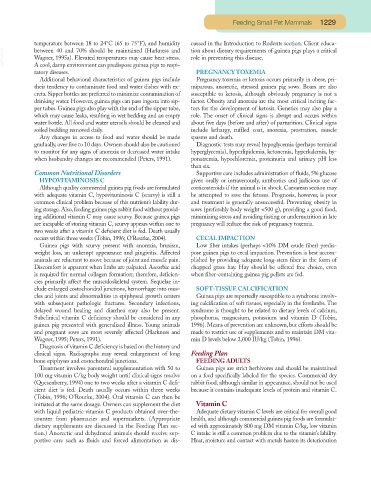Page 1179 - Small Animal Clinical Nutrition 5th Edition
P. 1179
Feeding Small Pet Mammals 1229
temperature between 18 to 24°C (65 to 75°F), and humidity cussed in the Introduction to Rodents section. Client educa-
VetBooks.ir between 40 and 70% should be maintained (Harkness and tion about dietary requirements of guinea pigs plays a critical
role in preventing this disease.
Wagner, 1995a). Elevated temperatures may cause heat stress.
A cool, damp environment can predispose guinea pigs to respi-
ratory diseases. PREGNANCY TOXEMIA
Additional behavioral characteristics of guinea pigs include Pregnancy toxemia or ketosis occurs primarily in obese, pri-
their tendency to contaminate food and water dishes with ex- miparous, anorectic, stressed guinea pig sows. Boars are also
creta.Sipper bottles are preferred to minimize contamination of susceptible to ketosis, although obviously pregnancy is not a
drinking water. However, guinea pigs can pass ingesta into sip- factor. Obesity and anorexia are the most critical inciting fac-
per tubes. Guinea pigs also play with the end of the sipper tube, tors for the development of ketosis. Genetics may also play a
which may cause leaks, resulting in wet bedding and an empty role. The onset of clinical signs is abrupt and occurs within
water bottle. All food and water utensils should be cleaned and about five days (before and after) of parturition. Clinical signs
soiled bedding removed daily. include lethargy, ruffled coat, anorexia, prostration, muscle
Any changes in access to food and water should be made spasms and death.
gradually, over five to 10 days. Owners should also be cautioned Diagnostic tests may reveal hypoglycemia (perhaps terminal
to monitor for any signs of anorexia or decreased water intake hyperglycemia), hyperlipidemia, ketonemia, hyperkalemia, hy-
when husbandry changes are recommended (Peters, 1991). ponatremia, hypochloremia, proteinuria and urinary pH less
than six.
Common Nutritional Disorders Supportive care includes administration of fluids, 5% glucose
HYPOVITAMINOSIS C given orally or intravenously, antibiotics and judicious use of
Although quality commercial guinea pig foods are formulated corticosteroids if the animal is in shock. Caesarean section may
with adequate vitamin C, hypovitaminosis C (scurvy) is still a be attempted to save the fetuses. Prognosis, however, is poor
common clinical problem because of this nutrient’s lability dur- and treatment is generally unsuccessful. Preventing obesity in
ing storage.Also,feeding guinea pigs rabbit food without provid- sows (preferably body weight <500 g), providing a good food,
ing additional vitamin C may cause scurvy. Because guinea pigs minimizing stress and avoiding fasting or undernutrition in late
are incapable of storing vitamin C, scurvy appears within one to pregnancy will reduce the risk of pregnancy toxemia.
two weeks after a vitamin C deficient diet is fed. Death usually
occurs within three weeks (Tobin, 1996; O’Rourke, 2004). CECAL IMPACTION
Guinea pigs with scurvy present with anorexia, bruxism, Low fiber intakes (perhaps <10% DM crude fiber) predis-
weight loss, an unkempt appearance and gingivitis. Affected pose guinea pigs to cecal impaction. Prevention is best accom-
animals are reluctant to move because of joint and muscle pain. plished by providing adequate long-stem fiber in the form of
Discomfort is apparent when limbs are palpated. Ascorbic acid chopped grass hay. Hay should be offered free choice, even
is required for normal collagen formation; therefore, deficien- when fiber-containing guinea pig pellets are fed.
cies primarily affect the musculoskeletal system. Sequelae in-
clude enlarged costochondral junctions, hemorrhage into mus- SOFT-TISSUE CALCIFICATION
cles and joints and abnormalities in epiphyseal growth centers Guinea pigs are reportedly susceptible to a syndrome involv-
with subsequent pathologic fractures. Secondary infections, ing calcification of soft tissues, especially in the forelimbs. The
delayed wound healing and diarrhea may also be present. syndrome is thought to be related to dietary levels of calcium,
Subclinical vitamin C deficiency should be considered in any phosphorus, magnesium, potassium and vitamin D (Tobin,
guinea pig presented with generalized illness. Young animals 1996). Means of prevention are unknown, but efforts should be
and pregnant sows are most severely affected (Harkness and made to restrict use of supplements and to maintain DM vita-
Wagner, 1995; Peters, 1991). min D levels below 2,000 IU/kg (Tobin, 1996).
Diagnosis of vitamin C deficiency is based on the history and
clinical signs. Radiographs may reveal enlargement of long Feeding Plan
bone epiphyses and costochondral junctions. FEEDING ADULTS
Treatment involves parenteral supplementation with 50 to Guinea pigs are strict herbivores and should be maintained
100 mg vitamin C/kg body weight until clinical signs resolve on a feed specifically labeled for the species. Commercial dry
(Quesenberry, 1994) one to two weeks after a vitamin C defi- rabbit food, although similar in appearance, should not be used
cient diet is fed. Death usually occurs within three weeks because it contains inadequate levels of protein and vitamin C.
(Tobin, 1996; O’Rourke, 2004). Oral vitamin C can then be
initiated at the same dosage. Owners can supplement the diet Vitamin C
with liquid pediatric vitamin C products obtained over-the- Adequate dietary vitamin C levels are critical for overall good
counter from pharmacies and supermarkets. (Appropriate health, and although commercial guinea pig foods are formulat-
dietary supplements are discussed in the Feeding Plan sec- ed with approximately 800 mg DM vitamin C/kg, low vitamin
tion.) Anorectic and dehydrated animals should receive sup- C intake is still a common problem due to the vitamin’s lability.
portive care such as fluids and forced alimentation as dis- Heat, moisture and contact with metals hasten its deterioration

